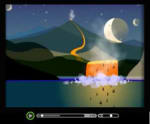Cell Structure
Cell Structure - The Complexity of the "Simple" Cell
Each person begins as a single cell -- a cell structure formed by the joining of the mother's egg and the father's sperm. That single cell contains the digital code to make thousands of other kinds of cells, from fat cells to bone cells -- from brain cells to lung cells. There are muscle cells, skin cells, vein cells, capillary cells and blood cells… Ultimately, from that one original cell, the human body will have something like 30 trillion cells conducting an orchestra of different functions.
In the first half of this century, scientists still assumed that the cell was a fairly simple blob of protoplasm. Without electron microscopes and other technology, the cell was treated as a "black box" that mysteriously performed its various functions -- an unobservable collection of "gelatin" molecules whose inner workings were unknown.
Through the marvels of 21st century technology, scientists now understand the following:
- Although the tiniest bacterial cells are incredibly small, weighing less than 10-12 grams, each is in effect a veritable micro-miniaturized factory containing thousands of exquisitely designed pieces of intricate molecular machinery, made up altogether of one hundred thousand million atoms, far more complicated than any machinery built by man and absolutely without parallel in the non-living world.1

As we delve further into the cellular world, technology is revealing black boxes within previous black boxes. As science advances, more of these black boxes are being opened, exposing an "unanticipated Lilliputian world" of enormous complexity that has pushed the theory of evolution to a breaking point. 2
Wow! That's at the cellular level. If the cell is that complex, what about the simplest organisms made up of these cellular structures? Is there really such a thing as "simple," now that we can view organisms using the latest in microbiological and biochemical technology?
Next Page!
Footnotes:
1 Denton, 250.
2 Michael J. Behe, Darwin's Black Box: The Biochemical Challenge to Evolution, Simon & Schuster, 1996, 18.

